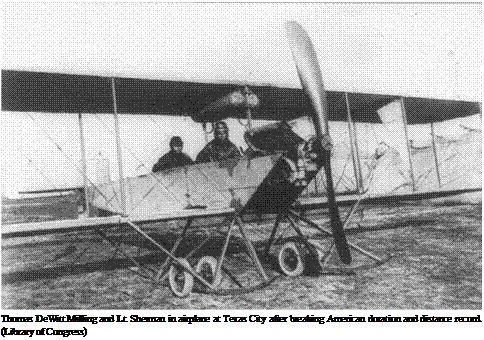1911
JANUARY 15 Flying in a Wright biplane at 1,500 feet, Lieutenant Myron S. Crissy drops a live 36-pound bomb on a target. The aircraft in question is flown by Philip O. Parmalee.
JANUARY 16 Over the San Bruno Hills, California, a Wright Flyer piloted by Lieutenant G. E. M. Kelly conducts the first aerial reconnaissance mission when he tries unsuccessfully to photograph and detect camouflaged troops from 2,000 feet.
JANUARY 17 At San Diego, California,
Glenn H. Curtiss opens an aviation school on North Island, which subsequently serves as the Signal Corps Aviation School.
JANUARY 21 Over Selfridge Field, Michigan, a Wright Flyer piloted by Lieutenant Paul W. Beck relays the first radio-transmitted message while airborne. The test is conducted at an altitude of100 feet and picks up a message 1.5 miles away.
FEBRUARY 7 Over Tijuana, Mexico, a biplane flown by Harry S. Harkness delivers a message to U. S. Army forces; the trip from San Diego, California, 25 miles distant, took only 25 minutes.
FEBRUARY 27 Near Fort McIntosh, Laredo, Texas, a Wright B Flyer piloted by Lieutenant Benjamin D. Foulois and Philip O. Parmalee demonstrates the potential of aircraft to cooperate with ground forces.
MARCH 3 In Washington, D. C., the Secretary of War authorizes the Army’s first aviation appropriation of $125,000 to fund 51 members of its Aviation Section.
Over Texas, a biplane flown by civilian pilot Philip Parmalee and Lieutenant Benjamin D. Foulois travels between Laredo and Eagle Rock to demonstrate the utility of such technology for relaying military communications.
MARCH 17 A Curtiss D pusher aircraft becomes the first machine adopted by the U. S. Army Signal Corps to utilize tricycle landing gear and it receives the designation Aeroplane No. 2.
MARCH 21 Over Fort William McKinley, Lieutenant Frank P. Lahm flies Signal Corps No. 7, a Wright Flyer, in the first overseas flight of an American warplane.
MARCH 31 In Missouri, the National Guard Signal Corps detachment organizes
an air section to teach aviation and ballooning for the first time.
April 5 At Fort Sam Houston, Texas, the first provisional aero company is organized by the U. S. Army.
April 11 At Augusta, Georgia, the Army
establishes its first, permanent flying school outside College Park, Maryland, and seeks permission to build four hangars. Fliers train there during winter months, although the school eventually relocates to San Diego, California.
APRIL 21 Lieutenant Henry H. Arnold is
ordered to Dayton, Ohio, for flight instructions at the Wright Flying School; he is accompanied by another early aviator, Lieutenant Thomas DeWitt Milling.
April 27 At Fort Sam Houston, Texas, a Curtiss IV Model D and a Wright Type B become the second and third Signal Corps small aircraft.
May 4 In Washington, D. C., the War Department approves the transfer of Signal Corps Aeroplane No. 1, the Wright Military Flyer, to the Smithsonian Institution, where it will be put on display.
May 7—13 In Dayton, Ohio, Lieutenants Henry H. Arnold and Thomas DeWitt Milling arrive for flight instruction at the Wright Flying School. They graduate six days later.
May 10 At Fort Sam Houston, Texas, a Curtiss D pusher aircraft piloted by Lieutenant George E. M. Kelly crashes, killing him. His becomes the first fatality in Army aviation history, and Kelly Field, San Antonio, is named in his honor in 1917.
 |
May 13 At Dayton, Ohio, Lieutenants Henry H. Arnold and Thomas DeWitt Milling graduate from the Wright aviation school.
June 7 At College Park, Maryland, Lieutenant John P. Kelly becomes the first medical officer assigned to the Signal Corps Aviation Field.
June 20 Captain Charles DeForest Chandler replaces Captain Arthur S. Cowan as head of the Aeronautical Division, Army Signal Corps.
July 3 At College Park, Maryland, the Signal Corps Aviation School is formally established under Captain Charles DeForest Chandler. He employs two lieutenants, Henry H. Arnold and Thomas DeWitt Milling, who recently earned their wings at the Wright aviation school at Dayton, Ohio.
September 4 Over Boston, Massachu
setts, Lieutenant Thomas DeWitt Milling is the first army pilot to finish the 160- mile tri-state air race. He arrives at night, guided by the light of gasoline flares outlining the landing zone.
September 26 Flying a Burgess-Wright biplane, Lieutenant Thomas DeWitt Milling wins the Rodman Wanamaker Trophy by flying a three-man flight for a duration of 54 minutes and 42 seconds.
September 30 Over Nassau Boulevard, New York, Lieutenant Henry H. Arnold serves as a “stunt pilot” during filming of the movie The Military Air Scout.
OCTOBER 10 Lieutenant Thomas DeWitt Milling is the first army pilot to test drop live bombs from an aircraft while using a primitive bombsight invented by Riley E. Scott.
OCTOBER 18 Captain George W. McKay of the Michigan National Guard is the first member of that branch of service to become qualified as a pilot.
November 5 Calbraith R. Rodgers completes the first-ever cross-country flight by touching down at Long Beach California in a Burgess biplane. It has taken him seven weeks to cover 3,220 miles and he remains airborne for a total of 82 hours and four minutes— Rodgers only glided in after his engine completely failed.
November 28 The Signal Corps Army Aviation School temporarily relocates from College Park, Maryland, to Barnes Farm in Augusta, Georgia, to enjoy better flying conditions. However, the region suffers from one of its worst blizzards on record and operations are suspended until the spring.










